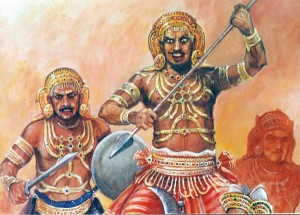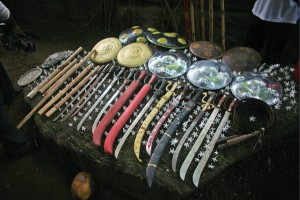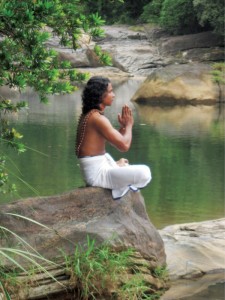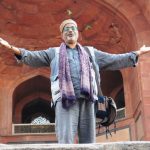Angampora is an indigenous martial arts form, the origins of which are buried in legend.
By Archt Kanchana Senasinghe | Photography by Karatota Ranapila


Present day teacher and pupils

Angam Pooja
As far back as 5000 years ago Vyshrava and Kaikashi gave birth to a son in the Yakka tribe, who becomes Rana Ravana, (master of the fields of medicine, music, art, dancing, mantra, technology, astrology and most importantly Angampora) the most feared and revered true martial art warrior of all time. Due to his mastery over ten sciences he gets referred to as Dasa Sheersha Pathi and thus gets depicted with 10 heads.
The art form “Angampora” is said to have transferred from father to son through his only son Indrajit to his two sons Keweshastha and Shavishailasha getting fragmented among the two. This martial arts form received royal patronage of Prince Tikiri or King Rajasingha of Seethawaka who effectively used it to defeat the Portuguese army in the famous battle of 1562. Aspects of Indian arts such as Sudaliya and Maruwalliya are also introduced into this local martial art form.
During the period of British colonial rule action was taken to suppress this art form by the gazette notification of 1827 led to teaching halls called Angam Madu being set ablaze and warriors shot

Ancient Yakkha warriors - By Prasanna Weerakkody
and killed. At this point in history Angampora becomes a secretive art, brought down from generation to generation, and a Sri Lankan version of “Ninja” called Illangakkara is born.
Angampora is not just a martial art but a truly indigenous way of life and a diverse sustainable culture.

Illangakkara (Local ‘Ninja” version)
In Korathota Navagamu Pattini Devalaya, surrounded by paddy fields, male and female youth train in the various aspects of Angampora in the Angam Maduwa built according to traditional Sinhalese architecture of Gebim Shasthraya, while some train in the open using training equipment made out of coconut tree trunks.
Under the guidance of a Panikki Rala, a senior of the art, masculine youth, dressed in white, limbs shining with the application of the special fighting oil and energetic lean, light female youth dressed in a white hattaya and cloth, engage in unarmed combat (Angam) known as, Guti haramba or Pora Haramba using limbs, pressure point combat (Maru Nila Shasthraya), armed combat using swords and shields, poles, sticks, knives, etc. (Illangam), and use of spells and incantations (Maya Angam)…..

Angam Weapons

Present day Female Fighter
A “Gurunnanse” sits in his chair at the special verandah of the Maduwa checking the astrological suitability and spiritual traits of prospective students to see that they will not bring unnecessary harm to people by the use of this powerful art since this was taught for one reason only –to protect their country, their faith and their culture….
Another group of students, a little distance away from the Angam Maduwa prepare medicines from the herbal garden of the centre….
Some practice a specialty known as Nila Wedakama (use of pressure points)…. Some engage in the traditional Yoga techniques that is unique to the country….
Some engage in meditation disciplining the mind comfortably unaware of all the hustle around to be able to harness and channel the energy that lies within…
Some dance and create music with drums…
Some chant mantras and some learn to draw yantras…..
This place exists.
If you are there you have truly travelled through time to a civilization of personality, leadership, pride, unity, sustainability and healthy individuals of mind and body.

Checking the horoscopes

Communing with nature

Channeling the energies
Gurunnanse sitting in his chair at the special verandah of the Maduwa checking the astrological suitability and spiritual traits of students to see that they will not bring unnecessary harm to people by the use of this powerful art since this was taught for one reason only –to protect their country, their faith and their culture…











